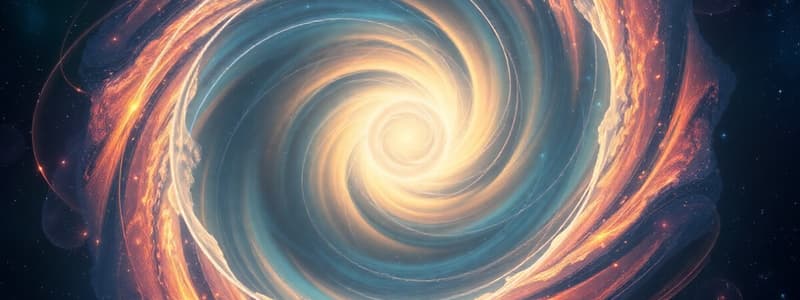Podcast
Questions and Answers
Why do individual particles on Earth experience varying gravitational forces from the moon?
Why do individual particles on Earth experience varying gravitational forces from the moon?
- Because particles nearer the moon feel a greater attraction force than those on the far side. (correct)
- As a result of the Earth-moon system as a whole being in equilibrium.
- Due to the centrifugal force being stronger on the side of the Earth facing the moon.
- Because all points on the Earth's surface describe the same motion around the common center of mass.
What is the primary cause of the true tide?
What is the primary cause of the true tide?
- The near-horizontal forces causing the flow of surface water. (correct)
- The indicated outward force at the points nearest and farthest from the moon.
- The gravitational pull of the sun.
- The centrifugal force acting on the Earth's surface.
How does the tilt of the Earth's axis affect the tides?
How does the tilt of the Earth's axis affect the tides?
- It only affects the timing, not the height, of high and low tides.
- It causes the highs and lows to be of unequal levels. (correct)
- It prevents the occurrence of high and low tides.
- It causes the highs and lows to be of equal levels.
Why is the sun's influence on tides less than that of the moon, even though the sun is much more massive?
Why is the sun's influence on tides less than that of the moon, even though the sun is much more massive?
During which lunar phases do spring tides occur?
During which lunar phases do spring tides occur?
How are neap tides characterized?
How are neap tides characterized?
If the moon alone produces a tide of 14 meters and the sun alone produces a tide of 6 meters, what is the range of a spring tide?
If the moon alone produces a tide of 14 meters and the sun alone produces a tide of 6 meters, what is the range of a spring tide?
What is the 'phase inequality of heights' primarily due to?
What is the 'phase inequality of heights' primarily due to?
Approximately how much longer is the mean lunar day than the solar day?
Approximately how much longer is the mean lunar day than the solar day?
What is the approximate time interval between a high water and the next low water?
What is the approximate time interval between a high water and the next low water?
Where is the common center of revolution between the Earth and the moon located?
Where is the common center of revolution between the Earth and the moon located?
What is the relationship between gravitational and centrifugal forces in the Earth-moon system?
What is the relationship between gravitational and centrifugal forces in the Earth-moon system?
If the moon is in quadrature, what type of tide is most likely to occur?
If the moon is in quadrature, what type of tide is most likely to occur?
Why are centrifugal forces the same everywhere on Earth's surface?
Why are centrifugal forces the same everywhere on Earth's surface?
If a location experiences high water, approximately how long will it take for the next high water to occur?
If a location experiences high water, approximately how long will it take for the next high water to occur?
How are the forces of the moon and sun aligned during a full moon, leading to a spring tide?
How are the forces of the moon and sun aligned during a full moon, leading to a spring tide?
What would be the range of a neap tide if the moon's tidal range is 14 meters and the sun's tidal range is 6 meters?
What would be the range of a neap tide if the moon's tidal range is 14 meters and the sun's tidal range is 6 meters?
What is one effect of the resultant forces from the gravitational and centrifugal forces?
What is one effect of the resultant forces from the gravitational and centrifugal forces?
When do neap tides occur relative to spring tides?
When do neap tides occur relative to spring tides?
What is the combined effect of the moon and sun during a spring tide?
What is the combined effect of the moon and sun during a spring tide?
Flashcards
What causes tides?
What causes tides?
Tides are caused by the gravitational effects within the Earth-Moon-Sun system and their movements.
What forces affect Earth's oceans?
What forces affect Earth's oceans?
The gravitational attraction between the Earth and Moon and centrifugal forces from their revolution around a common center.
Effect of the moon
Effect of the moon
Points on Earth's surface nearest and farthest from the moon experience higher water levels. Areas between experience lower levels.
Daily tidal patterns
Daily tidal patterns
Signup and view all the flashcards
Combined effect of Moon and Sun
Combined effect of Moon and Sun
Signup and view all the flashcards
Spring Tides
Spring Tides
Signup and view all the flashcards
Neap Tides
Neap Tides
Signup and view all the flashcards
Lunar day
Lunar day
Signup and view all the flashcards
Study Notes
- Tidal theory starts with a spherical Earth uniformly covered with water for simplicity.
- The effects of the moon and sun are considered separately, then combined.
- Tides result from gravitational effects within the Earth-Moon-Sun system and the movements of these bodies.
Effect of the Moon
- Tides are influenced by the gravitational attraction between the Earth and the Moon.
- Centrifugal forces also play a role, resulting from the revolution of the Earth and Moon around a common center located about 810 miles (1500 km) beneath the Earth's surface.
- Gravitational and centrifugal forces are balanced, preventing the Earth and Moon from colliding or drifting apart.
- The Earth-Moon system is in equilibrium.
- Centrifugal force is constant across the Earth's surface, acting parallel to the line joining the centers of the Earth and Moon.
- Gravitational force varies, being stronger for particles nearer the Moon.
- The combination of gravitational and centrifugal forces causes water to flow towards points on Earth's surface nearest and farthest from the Moon.
- This flow leads to higher water levels at these points and lower levels where the water flows from.
- The outward force at the nearest and farthest points is minimal.
- The true tide arises from near-horizontal forces that cause the water flow.
- As the Earth rotates, each point experiences two high tides and two low tides daily.
- The tilt of the Earth's axis causes the high and low tides to have unequal levels.
Effect of the Sun
- The sun affects the tides
- The sun's mass is much greater than the moon's.
- The sun's effect on tides is about 46 percent as strong as the moon's due to its distance.
- Tides are a result of combined lunar and solar influences.
Spring and Neap Tides
- Spring tides occur when the moon and sun are aligned with the observer's meridian.
- At the new moon, the forces of the moon and sun combine, creating a spring tide.
- Spring tides also occur at the full moon, about 14.5 days later, when the moon and sun are in opposition and their forces align.
- Neap tides occur about seven days after spring tides, when the moon is in quadrature.
- During neap tides, the high water due to the moon coincides with the low water due to the sun, resulting in a smaller tidal range.
- The range at neap tides is expressed as (M2 - S2).
- Neap tides occur when the gravitational forces of the Moon and Sun are perpendicular to each other.
Tidal Range Example
- If the moon produces a tide range of 14 meters and the sun produces a range of 6 meters:
- At spring tides (M2 + S2) = (14 + 6) = 20 meters.
- At neap tides (M2 - S2) = (14 - 6) = 8 meters.
- The phase inequality of heights, caused by the moon's phase, is the 12 meter difference.
Lunar Day
- The mean lunar day is about 50 minutes longer than the solar day.
- The interval between high water on one day and the corresponding high water on the next day is about 24 hours and 50 minutes.
- The interval between high water and the next low water is about 6 hours and 12 minutes.
Studying That Suits You
Use AI to generate personalized quizzes and flashcards to suit your learning preferences.




